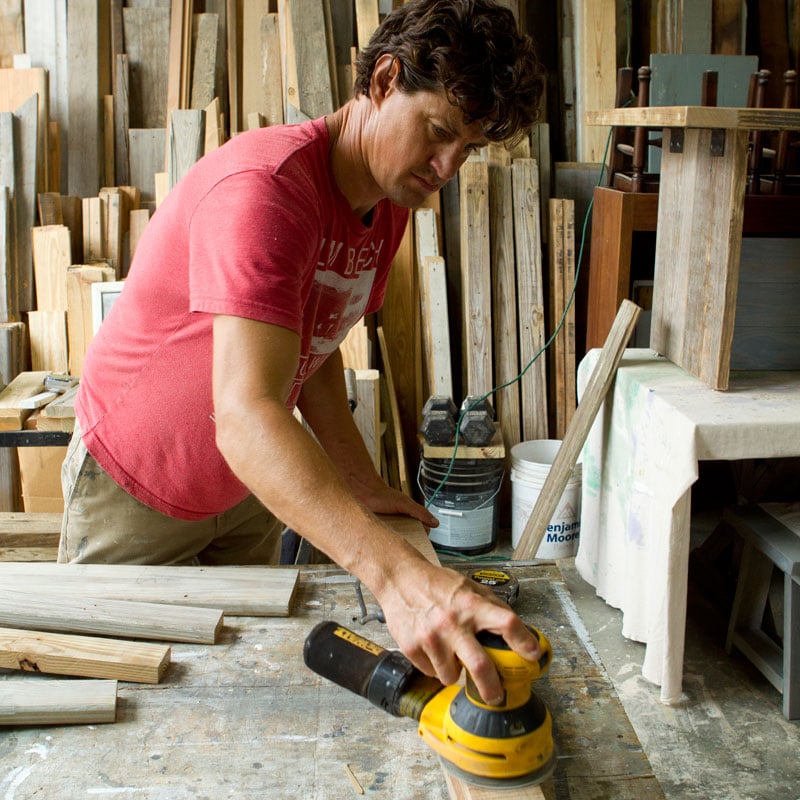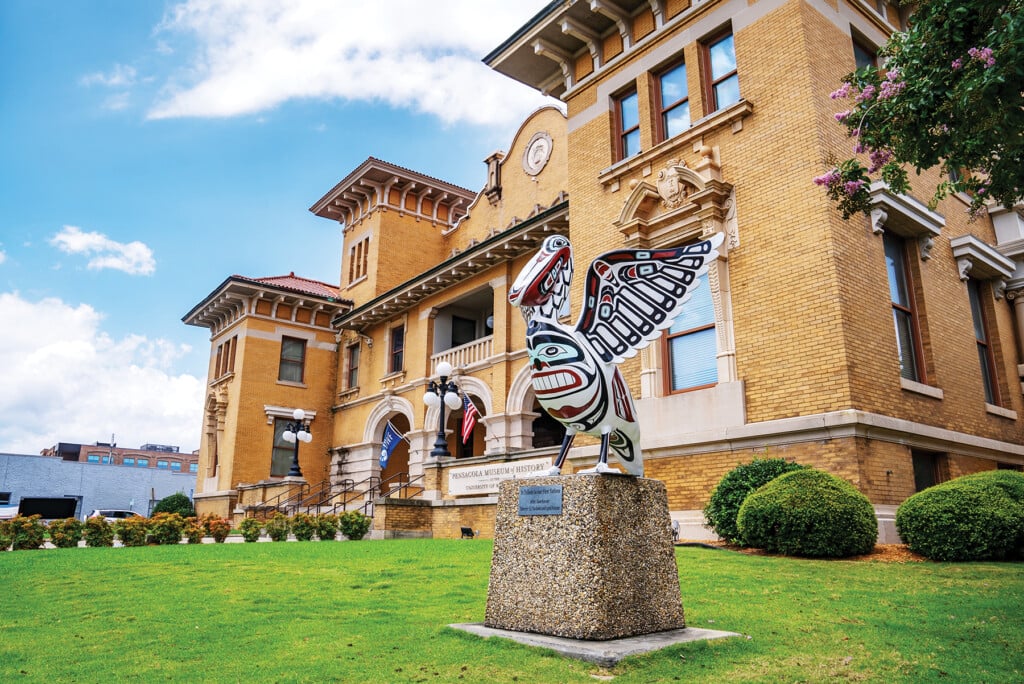Local Artisans Renew, Redesign and Repurpose Furniture
Brothers of Re-invention

Some of the trendiest furniture and fixtures in Emerald Coast homes began their useful life as something completely different. In the hands of skilled local artisans, broken furniture and old pieces of wood are given a second life as pieces as diverse as porch swing beds and formal dining tables. These beautiful yet functional furnishings are in demand by people who prefer one-of-a-kind pieces with plenty of character, or interior designers seeking custom pieces to add an eye-catching flair.
Brett Martin, owner of Made on 30A custom coastal furniture, believes that his redesigned and repurposed pieces are a perfect fit with the laid-back lifestyle here on the coast. “My pieces are not precise and not perfect,” he says, tucking his unruly brown curls back behind his ear. “I think people here kind of have that same mindset. They want one-of-a-kind, made locally. People drawn here really buy into that. I think you come here to get away from that ‘production line’ way of living.”
 Like most of the furniture he creates, Martin, 45, began his working life with a different purpose. The Georgia native had a screen-printing business in Athens and Columbus, Ga., prior to making his vacation home at the beach a full-time home in 2007. He started working in construction and creating furnishings out of his home but soon moved to the high-ceilinged warehouse his business now occupies on County Road 393 in South Walton. The metal building typifies the organized chaos of creativity, with a light layer of sawdust sprinkled on top. Martin’s keen eye sees a day bed in a section of old fence found at a construction site; a cypress coffee table from pieces of an old pergola; a porch swing in leftover material that builders have given him. Dressed in a surfer T-shirt and shorts, the artisan fondly touches each piece of wood as he recounts its history.
Like most of the furniture he creates, Martin, 45, began his working life with a different purpose. The Georgia native had a screen-printing business in Athens and Columbus, Ga., prior to making his vacation home at the beach a full-time home in 2007. He started working in construction and creating furnishings out of his home but soon moved to the high-ceilinged warehouse his business now occupies on County Road 393 in South Walton. The metal building typifies the organized chaos of creativity, with a light layer of sawdust sprinkled on top. Martin’s keen eye sees a day bed in a section of old fence found at a construction site; a cypress coffee table from pieces of an old pergola; a porch swing in leftover material that builders have given him. Dressed in a surfer T-shirt and shorts, the artisan fondly touches each piece of wood as he recounts its history.
Martin says the inspiration for his work often comes from raw materials like construction scraps, items others throw away or old pieces his father finds near his home in Georgia. Recently, however, interior designers and shoppers who spot his work in 30A boutiques have contacted him requesting custom pieces. “They like a certain piece that they see but want it in another size or another color,” Martin says. “I like when someone tells me what they want and I get to do it.”
A bright pistachio-colored marlin that presides over his workshop from above a doorway is a good example of Martin’s resourcefulness and creative approach. He was driving out of Sandestin Golf and Beach Resort behind a contractor’s pick up truck and noticed the large fish. “It was all beat to heck,” he says. “I stopped him and asked if he was going to throw it away. He said I could have it. I cleaned it up and painted it that color to match some furniture in my brother’s condo.” The marlin found its current home in Martin’s workshop after his sister-in-law vetoed its addition to the condo.
Martin is delighted that his day-to-day work is what others consider a hobby. “All my life — even growing up — I always liked to do hands-on work,” he says, patting a dining table made of reclaimed wood with the top covered in scrap metal roofing. “Every weekend as a kid, we went to a cabin my folks had on the Chattahoochee. I would build things with my dad for our cabin.” Martin also became interested in fishing, a hobby he still enjoys in area coastal waters.
 Brett Henry, 27, left construction work to begin recreating furniture, starting work from his garage about 18 months ago repairing broken furniture from Ava’s Attic, the furniture consignment and resale business owned by his mother and sister. His business grew to the point that Henry leased space in the same shopping center as Ava’s Attic on Highway 98 in Miramar Beach. “I never thought I would be doing this full time,” he says, gesturing at the several rooms chock full of furniture that are either works-in-progress or waiting for his attention. “I like this much better than construction. No 24-foot ladders.”
Brett Henry, 27, left construction work to begin recreating furniture, starting work from his garage about 18 months ago repairing broken furniture from Ava’s Attic, the furniture consignment and resale business owned by his mother and sister. His business grew to the point that Henry leased space in the same shopping center as Ava’s Attic on Highway 98 in Miramar Beach. “I never thought I would be doing this full time,” he says, gesturing at the several rooms chock full of furniture that are either works-in-progress or waiting for his attention. “I like this much better than construction. No 24-foot ladders.”
Pointing out a sinker cypress wall mostly hidden behind a couple of headboards and a chest, Henry explains that he had a vision of a showroom with a round table near the front and a display of benches to one side. Instead, the intended showroom has become a waiting area for a wall-to-wall line of projects and a pile of sea-sculpted driftwood pieces that hints the artisan’s golden tan may owe as much to beachcombing as to once working construction. The larger back room of the strip center space is mostly devoted to the work area and material storage.
Henry and his Ava’s Attic Furniture Company have both a source of new materials and a way to market its wares in the nearby Ava’s Attic. In fact, a specific piece of frequently discarded furniture is among his earliest success stories. “Almost every house or condo around here had a TV armoire,” Henry says. “When flat-screens came in, people began getting rid of the old armoires to upgrade. We had so many of them that I came up with different ways to re-do them.” He re-purposes the obsolete armoires into benches, porch swings, chests of drawers, hall trees — whatever he sees in the aging pieces. Many armoires mix particle board with authentic pieces of wood, so Henry replaces the weaker board with “real” wood.
Many broken or out-of-fashion furnishings make the trip across the shopping center from Ava’s Attic to receive a new life from Henry. When an assistant carries in a chair with a broken leg, Henry interrupts a conversation to examine it with keen blue eyes and his artisan’s hands, eager to start his triage and make it better-than-new.
Custom work was a natural outgrowth of the family enterprises, with customers seeing his work in the Ava’s Attic showroom and requesting a different size or color. “We probably get two or three people a week,” he says.
Customers began to bring him heirloom pieces that they didn’t necessarily want to use in their present form, but that meant too much to give or throw away. “People don’t want to get rid of Grandmother’s headboard but they don’t want to use it, particularly full-size headboards that nobody uses anymore,” Henry says. “We make a lot of them into porch swings.” The swings are beautifully carved and a perfect size for a porch.
 Henry has branched out into using many types of wood, from the most popular sinker cypress (cypress logs that have sunk underwater and stayed there many years) to old doors, shutters and other scrap wood. “I just made a hall tree from a 250-year-old door from Mississippi,” he says. “I just got cypress from a hundred-year-old house in Point Washington. We make bird houses and frames from driftwood.” The artisan works six days a week trying to keep pace with inspiration and demand.
Henry has branched out into using many types of wood, from the most popular sinker cypress (cypress logs that have sunk underwater and stayed there many years) to old doors, shutters and other scrap wood. “I just made a hall tree from a 250-year-old door from Mississippi,” he says. “I just got cypress from a hundred-year-old house in Point Washington. We make bird houses and frames from driftwood.” The artisan works six days a week trying to keep pace with inspiration and demand.
“You can bring old stuff that won’t sell, and we can fix it up so it will sell around here,” he says. Sometimes, updating can be as simple as changing the finish or color. Working with wood and repairing not-so-new items led Henry to develop his own line of wax and chalk paint that is particularly suited for his work. Called Romantique, it will adhere to any type of surface without sanding it first. Customers can purchase the paint out of his showroom/workshop.
Not everyone is a hands-on person, so Henry soon found customers asked him to come to their homes and work on things like cabinets and walls. “We just faux-finished cabinets to look like driftwood and added new hardware,” he said. “We also do things like board-and-batten walls.”
If you are looking to add a one-of-a-kind piece, or an inspired way to update some aging furniture, these furniture artists can help create or recreate the coastal look of your home or office.


